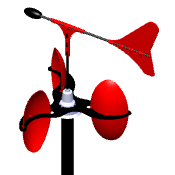How an Anemometer Can Boost Your Weather Surveillance System
How an Anemometer Can Boost Your Weather Surveillance System
Blog Article
Discovering the Functions and Benefits of Anemometers for Weather Lovers and Experts
Anemometers stand as critical devices in the realm of climate surveillance, accommodating both fanatics and seasoned experts alike. These gadgets supply a home window into the dynamic world of wind patterns and speeds, offering vital data for meteorological analysis and forecasting. From cup anemometers to sonic anemometers, each type brings its special set of advantages and applications, clarifying various aspects of atmospheric conditions. As we delve right into the features and benefits of anemometers, a deeper understanding arises not just of dominating weather condition sensations however likewise of the wider implications for sectors like wind energy production and ecological study.
Relevance of Anemometers in Weather Condition Surveillance
Anemometers play a critical function in weather monitoring by giving precise dimensions of wind speed, assisting in projecting and understanding weather condition patterns. These tools, varying from typical mug anemometers to contemporary ultrasonic anemometers, are vital for meteorologists, researchers, and climate enthusiasts alike. By measuring wind rate, anemometers help in establishing the intensity of climate phenomena such as tornados, tornadoes, and storms. Additionally, they offer beneficial information for aviation, maritime procedures, and numerous industries that are delicate to wind problems.

Kinds Of Anemometers and Their Applications
The most typical types of anemometers include cup anemometers, vane anemometers, hot-wire anemometers, and ultrasonic anemometers. Cup anemometers are composed of 3 or four mugs installed on horizontal arms that turn with the wind, measuring its rate. Vane anemometers, on the other hand, make use of an easily turning vane to straighten with the wind direction, giving both wind speed and direction measurements.
Mug anemometers are suitable and robust for general weather condition monitoring, while vane anemometers are favored for directional measurements. Ultrasonic anemometers are non-intrusive and supply high precision, usually utilized in study and specialized weather condition surveillance applications.
Advantages of Utilizing Anemometers in Forecasting
In meteorology, the use of anemometers offers vital advantages for improving the accuracy of weather projecting. Anemometers measure wind speed and instructions, giving critical data for forecasting weather condition patterns. By incorporating wind information into projecting versions, meteorologists can much better recognize the movement of climate systems, expect changes in weather, and concern a lot more accurate forecasts.
Furthermore, anemometers play a crucial function in evaluating potential weather hazards. Monitoring wind rates aids forecasters anticipate serious weather occasions such as cyclones, twisters, and winter months tornados with higher precision. This very early warning system enables authorities to provide timely informs and apply essential precaution, lowering the dangers to life and residential property.
Additionally, anemometers help in maximizing renewable resource manufacturing. By analyzing wind patterns, meteorologists can recognize ideal places for wind ranches and predict power outcome, adding to the reliable generation of wind power.

Anemometers in Wind Energy Manufacturing
Offered the essential role anemometers play in supplying precise wind data for weather condition forecasting and risk evaluation, their relevance prolongs to the realm of wind energy production. Anemometers are necessary instruments in the area of wind energy, where the measurement of wind rate and direction is crucial for identifying the usefulness and effectiveness of wind turbine installments. By accurately measuring wind rates at differing heights, anemometers help maximize the placement and layout of wind turbines to take full advantage of energy outcome.
In wind farms, anemometers are tactically positioned to gather real-time wind data that is used to assess the potential power production of a site. This data contributes in identifying the economic stability of wind power tasks and in forecasting energy generation to make sure grid security. Additionally, anemometers aid in checking wind conditions to maximize wind turbine performance, prevent damage from high winds, and guarantee the safety of sites employees operating in the area of wind generators.
Enhancing Climate Comprehending With Anemometers

Anemometers play a key role in enhancing our understanding of microclimates. These localized weather can vary dramatically from broader local projections, making it vital to have exact data for specific areas. anemometer. By purposefully positioning anemometers in various places, researchers can collect thorough information on exactly how wind acts in different terrains, urban environments, or bodies of water
Additionally, anemometers add to boosting weather forecasting models by offering real-time data on wind behavior. This information is particularly beneficial for anticipating severe weather events, maximizing agricultural practices, and supporting sectors like aeronautics and maritime navigating. Generally, anemometers are very useful instruments that allow us to dig deeper right into the complexities of climate systems, eventually resulting in even more precise predictions and better-informed decisions.
Verdict
To conclude, anemometers play a crucial duty in climate link surveillance and forecasting by measuring wind speed and direction. They are crucial devices utilized by weather fanatics and experts to gather exact information for anticipating weather condition patterns and evaluating possible effects. Anemometers likewise have applications in wind power manufacturing, further highlighting their value in both meteorology and eco-friendly energy markets. On the whole, anemometers add to improving our understanding of weather condition phenomena and enhancing projecting capabilities. anemometer.
From mug anemometers to sonic anemometers, each type brings its one-of-a-kind collection of benefits and applications, shedding light on numerous elements of atmospheric problems. These tools, ranging from standard cup anemometers to modern ultrasonic anemometers, are essential for meteorologists, researchers, and climate enthusiasts alike. The most typical types of anemometers include cup anemometers, vane anemometers, hot-wire anemometers, and ultrasonic anemometers. Mug anemometers are appropriate and durable for basic weather surveillance, while about his vane anemometers are preferred for directional measurements. Anemometers are crucial tools in the field of wind power, where the measurement of wind rate and direction is critical for determining the feasibility and efficiency of wind turbine setups.
Report this page